Story of Muthappan
In Payyavoor village there was a Brahmin family known as Ayyankara. The lady of the Ayyankara royal family went for her usual bath in the nearby Payyvur river. As she was bathing, she heard a ringing sound, similar to the sound made by anklets. To her surprise she spotted a baby floating in a basket of flowers in the river water. Anxious for a child, she immediately took the boy home. Her husband considered the baby to be a blessing from their god Shiva. The child grew up. In his youth, he was fond of hunting and he would often kill birds and animals and would consume their roasted flesh. This practice was highly unacceptable in the eyes of his parents, for which the boy would often receive scolding. Unable to bear this, one day the boy decided to leave home. On seeing that his mother was reluctant to let him leave, he looked at her in fury with fiery eyes. On seeing this terrible expression of her son, she bowed to him and understood that her son was no ordinary boy. Thus, his divinity was revealed and he was thus understood to be Muthappan.
He obeyed that he would wear the "Poikannu" to conceal the original as that eye may make fire in order to create "Santi and Samabavana" Muthappan at his childhood was always for the benefit of downtrodden and poor people. The mother knew that he is godly gift and leave Ayyankara. He left Ayyankara and reached Kunnathurpadi, Puralimala, Thillenkeri, Kannapuram, Parassinikadavu and Valluvankadav. In Kunnathurpadi, Chantan a tribalman was his friend. He wanter always with his dog., He saw Chantan was tapping from Palm tree. The boy requested to give him toddy. But Chantan ignored it. All of sudden he transformed into a stone. His wife prayed that she would offer the boy "oottu" and "Tiruvappana" and "amruthakalasam" in the month of Dhanu . Suddenly Chantan appeared. Therefore, the Chantan family started to do the pooja for the boy and started to call "Muthappan". In the Kunnathurpadi royal family called karakatttidam nayanar learned this and invited Muthappan. Henceforth Muthappan pooja started. The god started his travel once again.
Every year in the month of Dhanu the festival in Kunnathur starts with Muthappan performance dressed by "Anhuttan" family member. The vellattam komaram also accompany them.
The Muthappan form in different way. The first tone in the form of boy, youg boy. Purankala Muthappan and finally Thiryvapan, which is now seen at Prassinikadav and Valluvankadavu.
The Muthappankavu and muthappan Madapuras are plenty in North Malabar. The Madppuras areas are blessed with rich growth of vegetation which provides setting for cool and calm atmosphere. All the Madappura are nearby rivers or hill top surrounded by different communities associated with Muthappan. The Vannan and anthuttan community is the most powerful theyyam artists. They are the traditional Muthappan artists. In theyyam, Thira season they are all busy with the Madapura festival.
Story of Valluvan Kadavu Muthappan Madappura
Origin of Valluvankadavu Madappura can be traced to a vision that Muthappan gave to a devotee who lived in Valluvankadavu centuries ago. This devotee was Karanavar (eldest man who is the family head) of an influential local family named Puthiya Valappil. This family owned many landed properties in Valluvankadavu as well as in other villages. Due to income from agriculture, they were extremely affluent.
This Karanavar, despite his immense wealth, was a hardworking farmer. Being devout, he was punctual with his prayers and rituals that he practiced on a daily basis. He was also a generous and charitable person. He always ensured that poor people in his village received grain from his private granaries during famines and lean months. Due to that, he was immensely popular with people of his village. Despite his wealth, he was always a modest person.
Once, during twilight, after he had his bath and prayers, he was strolling in the front-yard of his house. Then as if directed by an unseen power, he walked towards the river bank. He stood on the shore for a while watching the river flow. It was dark by then. Then suddenly an unusually bright source of light appeared on the surface of river. This was followed by a figure – shrouded in smoke- appearing on the river surface.
The saintly Karanavar was overwhelmed by what he saw. He felt a joy that he never felt before in his life. He looked carefully at this figure and bowed respectfully to him. Then he realized – on the basis of the figure’s appearance – that this figure was none other than Muthappan himself! Due to extreme joy, he tried to walk through water towards the divine figure– but an unknown force flung him back to the shore and he fell unconscious. When he regained consciousness, Muthappan had vanished – but the Karanavar started to wander in that river shore in search of Muthappan. He was also loudly chanting names of God as he wandered.
Then he realized that the Muthappan had disappeared. But he was still in a state of supreme bliss. He rushed back to his house. His family members were scared to see him in a state of extreme bliss – contrary to his usual composed self. He then headed straight to sanctum sanctorum of the house. He then prepared for a Painkutti, prepared favorite Nivedyam of Muthappan and fell in prostration before Muthappan. He prayed loudly totally unaware of his surroundings. Then he fell once more into unconsciousness. His family members who were unaware of what happened felt extremely worried at his behavior.
As he lay unconscious, Muthappan appeared him in his dream and spoke thus – “You have seen me. And know that I will be always with you.” Then he regained consciousness. He then spent the rest of the night chanting names of Muthappan.
He was a changed man after he got vision of Muthappan. He became more radiant than before and spent more time in prayer and ritual. He regularly conducted Painkutti for Muthappan at his house. He also ensured divine favor by regular conduct of Vellattam at his residence. Then as per revelations in an astrological consultation, worship of Edalapurath Chamundi was done at Kottilakam of the house as well as worship of Gulikan as Upadevan. Karanavar became known as Guru.
Due to veneration of Muthappan, entire village got blessed and changed for better – there were no more floods and epidemics in the village. Unprecedented contentment and prosperity appeared in the area. People from distant lands flocked to seek blessings of Muthappan here. Guru conducted all the rites and rituals as Madayan until his death.
After his death, his successors continued his rites and rituals as per prescription. But in course of time, there was steady increase in failure to conduct rituals – culminating in total abandonment of the site as seat of Muthappan. It showed its effect by a host of evils befalling the family and village in various ways. But divine presence of Muthappan remained intact in this site – as attested by various astrological analysis and experience of local devotees. Then as if by will of Muthappan and the Guru, a descendant of Guru took charge of this holy site.
Then, as atonement for sins, consecration was done after building a Gurusthanam and Madappura. Valluvankadavu Muthappan Trust was established under leadership of Ariyambatt Mukundan. Trust had been successful in revival of Valluvankadavu as a centre of veneration of Muthappan. Today, pilgrims come from distant areas regularly. At present, Valluvankadavu Muthappan Madappura can rival any major temple of Kerala as sacred site.
Valluvankadavu Muthappan Madappura is located in Kannadiparamba village of Kannur district on the banks of Valapattanam River.The Temple is open to devotees of all religions and castes. In addition of Lord Muthappan, devotees are also blessed by divinities like Guru, Edalapurath Chamundi, Gulikan and Nagam. Devotees must first pray and circumambulate Gulikan and Nagam and then pray to Edalapurath Chamundi. Only then must they proceed to pray to Muthappan. Temple will be open on all days from 5 am to 10 am and 4.30 pm to 8.30 pm. Ottu and Vellattam will be conducted on all Sundays. Thiruvappana and Vellattam on all first Sunday and Monday of each month. Thiruvappana Mahotsavam will be conducted from January 1 to January 7. A dining hall with the capacity for five hundred persons is attached to temple. Sarasvati Mandapam hall for functions like marriages. As a part of humanitarian service, temple has been distributing Ayurveda medicines and treatment in collaboration with local Ayurveda hospital to local people and pilgrims free of cost. Thousands avail the benefit of free treatment given on Sundays. There is also a welfare center with all modern facilities attached to temple.
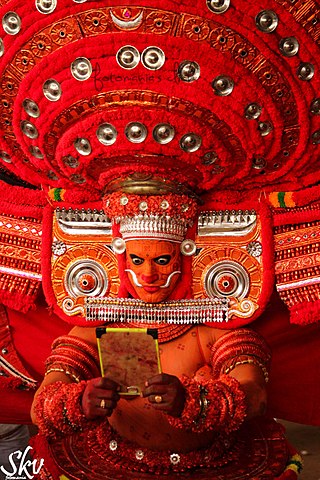
Theyyam are Hindu ritual practiced in northern Kerala and some parts of Karnataka. Theyyam is also known as Kaḷiyāṭṭaṁ or Tiṟa. Theyyam consists of traditions, rituals and customs associated with temples and sacred groves of Malabar. The people of the region consider Theyyam itself as a channel to a god and they thus seek blessings from Theyyam.

Parassinkkadavu is a small Temple town in Anthoor Municipality. This town is located about 19 km (12 mi) from Kannur Corporation in the Kannur district of Kerala state, India. It is a famous tourist destination in North Malabar.
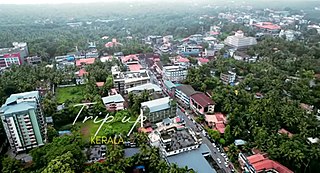
Vatakara,, also spelled Vadakara, French: Bargaret, is a Municipality in the state of Kerala, India. Vatakara is located between Kannur and Kozhikode. The municipality of Vatakara covers an area of 23.33 km2 (9.01 sq mi) and is bordered by Mahé to the north and Payyoli to the south. It is the headquarters of Vatakara taluk, which consists of 22 panchayats. During the reign of the Kolathiris and Zamorins, Vatakara was known as Kadathanadu. During the British Raj, it was part of the North Malabar region of Malabar District in the state of Madras. The historic Lokanarkavu temple, made famous by the Vadakkan Pattukal, is situated in Vatakara. A new tardigrade species collected from Vadakara coast has been named after Kerala State; Stygarctus keralensis.

Parassinikadavu Muthappan temple is a temple located at Parassinikadavu in Anthoor municipality on the banks of the Valapattanam river about 10 km (6.2 mi) from Taliparamba and 20 km (12 mi) from Kannur town in Kannur district, Kerala, India. Thiyya community urayima Principal deity of the temple is Sree Muthappan, whose divinity is presented as a ritualistic theyyam enactment in two versions called Thiruvappan and Vellattam. According to the local tradition the presiding deity is a manifestation of Lord Shiva.
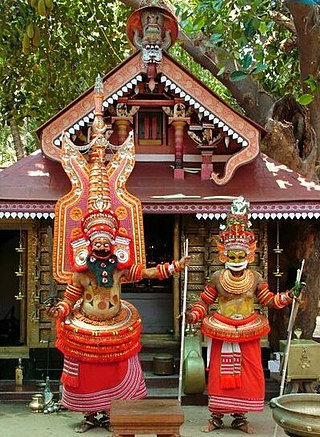
Muthappan is a deity commonly worshiped in the Kannur, Kasargod, Kozhikode, Malappuram region of Kerala and Coorg region of Karnataka in India. Muthappan is considered as the personification of two Hindu gods — the Thiruvappan or Valiya Muthapan (Vishnu) and the Vellatom or Cheriya Muthapan (Shiva).
Kunnathur Padi is the historic center for the folk Hindu deity Sree Muthappan. The center stands in Payyavoor Grama Panchayat, Kannur District of the Kerala state of India, 3,000 feet above sea level, on top of Udumbumala in the Sahyadri mountains. The region belonged to the kingdom of the Mannanar dynasty, the line of Muttappan. In 1902, Kunhikelapan Mannanar, the last king of this dynasty of Muthappan's clan, was killed and the British government seized the property of this dynasty, and Karakattidam Nayanar, a vassal of Mannanar, got the right to manage Kunnathur Padi.

Sivagiri is an area in Varkala Municipality of Thiruvananthapuram district in Kerala. It is a pilgrimage centre of Varkala Town where the tomb, or samadhi, of Sree Narayana Guru is situated. It is a place where Guru built the Sarada Temple dedicated to Sarada Devi. The tomb is an attraction for thousands of devotees every year, especially during the Sivagiri Pilgrimage days from 30 December to 1 January.
Kannapuram is a census town and grama panchayat in Kannur district of North Malabar region in the Indian state of Kerala.
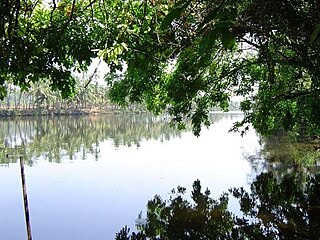
Mukkunnu is a village in Pariyaram Panchayath near Taliparamba in the Indian state of Kerala.

Pattuvam is a village in Kannur district in the Indian state of Kerala. It is bordered by the Kuppam river on the north, west and south. It shares a border with Taliparamba municipality on the east. A bridge over the river connects Pattuvam to Kottakkeel of Ezhome village in the northwest.
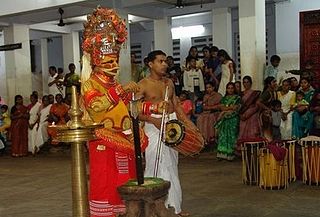
Nileshwar Muthappan Madappura is a temple dedicated to the God Sree Muthappan in the town Nileshwar of Kasaragode district, Kerala state, South India. Sree Muthappan is the most popular local god in Kannur district and Kasaragod district of north Kerala.

Sree Andalurkavu is a famous and prominent Thiyya Community Urayima temple in Andalur in Dharmadam village of Kannur district, North Kerala. This old temple is in the name of Lord Rama and the main festival is celebrated in mid-February: the first week of the month "Kumbam" of the Malayalam calendar. This Kavu also has a story of how the Kalaripayat warrior Thacholi Othenan, who once caused trouble in this Thiyar-dominated Kavu Andalur of Thalassery, was punished and defeated by the Thiyars and crossed the country through the bridge.
There are places of worship considered important in the Kannur district. Kannur District is one of the 14 districts in the state of Kerala, India. The town of Kannur is the district headquarters, and gives the district its name.
Mavichery is a village which is the part of Pariyaram Gramapanchayath in the Kannur district of Kerala, India.

Vishnumoorthy Theyyam is a Thiyya community temple ritual form of dance worship in Kerala and Karnataka, India. Theyyam consisted of several thousand-year-old traditions, rituals and customs. The performance includes complicated rites and rituals. The peculiar drum-beats can be heard up to a distance of 2 km from where the performance of the Vishnumoorthi Theyyam takes place. The enactment involving the Narasimha Avatar of Lord Vishnu by the Koladhari especially thrills the devotees and the spectators as a result of the body movements involved in it.
The Thalassery carnival, the Beach fest in Muzhappilangad beach and Dharmadam beach are notable attractions. The area's four rivers around Thalassery town and four beaches with more in Kannur also attract visitors.

Altharakkal Sree Muthappan Madapura is a temple, located at Pullur Village about 6.2 km from Kanhangad City and 25 km from Kasaragod City in Kasaragod District, Kerala. Principal deity of the temple is Sree Muthappan, whose divinity is presented as a ritualistic theyyam enactment in two versions called Thiruvappana and Vellattam. According to the local tradition the presiding deity is a manifestation of Lord Shiva.

Mappila Theyyams are a variant of Theyyam performed in North Malabar especially in Kasaragod district it is related to the Mappila Muslims of Malabar Coast. This Theyyam is deified by Mavilan, Koppalan and Vannan communities and is done with the cooperation of Hindus and Muslims. The characters of this theyyam are mostly spirits of Mappilas that are related to the local deities. The common names of male Mappila theyyams are Aali, Aandi, Mukri, Poker, Bappiriyan, Kunhali, Mammu, Mammad etc. Ummachi and Naithiyar are the common names attributed to female theyyams.The dialogues of Mappila theyyams have mentions about Islamic migration to Kerala in the 7th century and communal harmony.
Devakkoothu also spelled as Devakoothu is a ritualistic dance performed in Kerala, India. It is the only theyyam performed by a woman. This theyyam is performed in the temple Tekumpad Koolom Thayakav near Cherukunnu in Kannur district. The goddess associated with Devakkoothu is called Valliyamma because she stayed at a forest of creepers, according to myths. Devakkoothu is performed once in two years.














